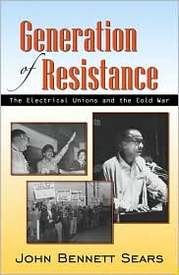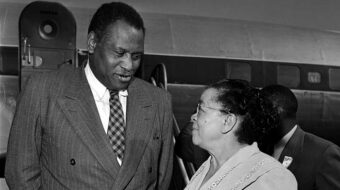
The struggles and the conditions of electrical workers through the Cold War years of the late 1940s and the 1950a are examined in depth in “Generation of Resistance” by John Bennett (Ben) Sears.
The Union of Electrical, Radio and Machine Workers of America (UE), founded in March 1936, supported F.D.R.’s policy of friendship and fair trade with the Soviet Union. That policy fell into disrepute as the Truman administration turned to Cold War politics. The book, subtitled The Electrical Unions and the Cold War, contrasts the positions of UE and the IUE, a rival union, regarding Cold War policies. By exploring the Cold War’s origins, reactionary labor leader’s acceptance and UE resistance, the book shows the damage that the contrived Cold War did to labor and to the country.
Sears writes that, in 1945, at the end of World War II, two trade union leaders, one the UE president and the other a former president visited the Soviet Union. They viewed the devastation from the war and called for continuation of a policy of cooperation between the U.S. and the U.S.S.R. Both trade unionists were impressed by Soviet resolve to rebuild. Albert Fitzgerald, the UE president throughout the Cold War, remained convinced of President Roosevelt’s policy. As the Truman administration abandoned the wartime policy of friendship and fair trade, the former union president, James Carey, also ditched his support and joined the “Cold War Establishment.” Thus Carey not only avoided the job-threatening Cold-War inquisitions, but he also received and accepted positions in the Truman administration, as the establishment considered acceptance by labor a Cold War requirement. But Carey never did succeed in bringing all of labor into the intended Cold War consensus.
Sears notes that official Washington policy had its start in a 1947 meeting of Truman’s State Department. The Cold War and “containment of communism” was not the State Department’s first choice. There had been discussion of ways of getting Soviet agreement for expansion of U.S. big business interests into post WWII Europe. Only “when this hope proved false” did the Truman administration begin its Cold War campaign. Apparently even the Cold Warriors couldn’t believe their own rhetoric.
A split in the CIO began in 1947 around the same time as the Truman administration began to turn away from F.D.R.’s call for cooperation with the Soviet Union. Several CIO leaders moved into the Cold War camp. By the year 1956, merger with UE became an important topic in the labor movement. But IUE leaders replied, “Unity Yes! Merger No!” Their reason was IUE’s carefully cultivated “world-wide reputation as a prime destroyer of Communist unionism.” A merger with UE would gravely affect the IUE’s “prestige.”
Sears notes that there is little evidence that those who accepted Cold War ideology did so because of belief that the Soviet Union was a threat. Some AFL-CIO leaders considered foreign policy “excursions” good for labor, and seeing their “respectability” was at stake, joined the anti-Communist crusade.
The book makes it clear that the UE “never abandoned its commitment to seeking alternatives to the nation’s foreign policy.” The UE “drew a connection between labor’s support for the Cold War and the passive attitude of many labor leaders on domestic issues.” Speaking at the 1958 UE convention, Brigadier General Hugh Hester “urged productive negotiations between the United States and the Soviet Union.” He reported, “Neither the Russian people nor the Russian leaders want war with the United States.” In response to the claim that “Stalin’s intransigence caused the Cold War while the West was perfectly willing to have a co-operative effort,” the brigadier general said, “I submit that is simply not true.”
The Truman administration also viewed the Cold War as a way of avoiding economic depression. IUE leaders accepted the Cold War as a means of creating jobs. UE disagreed and maintained that the Cold War was an expensive, inefficient, and contrived way of running the country. UE’s calls for shorter work week (with no cut in pay) and health care for all were stifled by key trade union leaders acceptance of the Cold War.
During the Cold War UE faced many crises: raids by IUE and other unions, economic dislocations, and menacing hearings.
When asked at one of the McCarthy hearing about whether he attended Communist Party meetings at his home, Arthur Owens, an African-American worker at a Schenectady, N.Y. plant and trustee of the national union, replied, “I certainly would like to answer that question the way it should be answered, but I realize that I am not before a good American democratic committee. I am before a Ku Klux Klan outfit. So because of that, I must use the privilege of the first and fifth amendments.”
UE leaders at 1952 hearings were permitted to give a prepared statement. They said in their statement “a careful and objective look at the facts thoroughly exposes such slanderous allegations…. The UE is a trade union, and as such, the overwhelming bulk of its activities have to do with basic trade-union questions and related domestic policies…. Without deviation, the UE had followed the policy developed by the late Franklin D. Roosevelt…. Had the members of this union declared that war profiteering is fine, we would not be here today. If our members had put their stamp of approval on the tax-price-wage squeeze that is wrecking the country’s living standards, we would not be charged with endangering the country’s security…. Had we called for atomic war, for $60 billion arms budgets, and for distributing America’s wealth to corrupt dictators like Franco and Chiang Kai-shek, we would not be under attack here.”
Author Ben Sears lists two objectives for this work: to describe the overwhelming adverse circumstances facing electrical unions in the Cold War, and to show UE’s success “in presenting a program and a vision of trade unionism that can be considered a viable alternative to the Cold War brand of unionism pursued by the leaders that dominated the AFL-CIO during the period covered.” Ben Sears has made a valuable contribution to the history of trade union struggles.
Book Review
Generation of Resistance: The Electrical Unions and the Cold War
Publisher, Buy Books on the Web.Com
352pp, paperback, $17.95












Comments